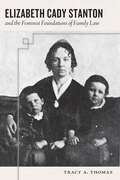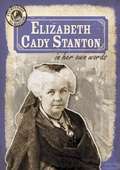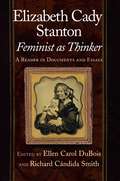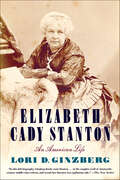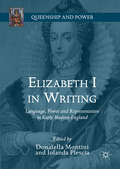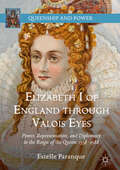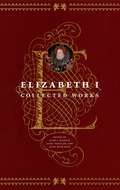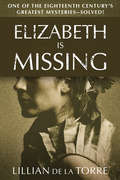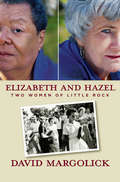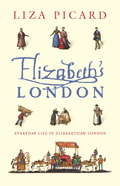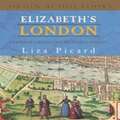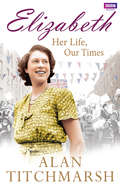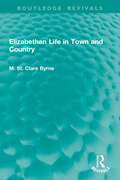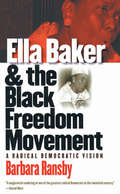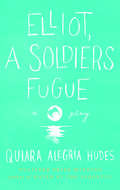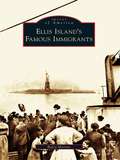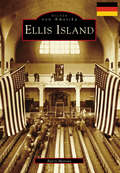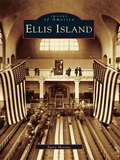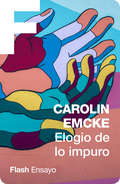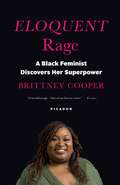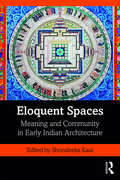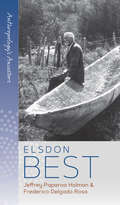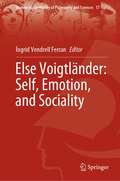- Table View
- List View
Elizabeth Cady Stanton and the Feminist Foundations of Family Law
by Tracy A. ThomasThomas Byers Memorial Outstanding Publication Award from the University of Akron Law Alumni AssociationMuch has been written about women’s rights pioneer Elizabeth Cady Stanton. Historians have written her biography, detailed her campaign for woman’s suffrage, documented her partnership with Susan B. Anthony, and compiled all of her extensive writings and papers. Stanton herself was a prolific author; her autobiography, History of Woman Suffrage, and Woman’s Bible are classics. Despite this body of work, scholars and feminists continue to find new and insightful ways to re-examine Stanton and her impact on women’s rights and history. Law scholar Tracy A. Thomas extends this discussion of Stanton’s impact on modern-day feminism by analyzing her intellectual contributions to—and personal experiences with—family law. Stanton’s work on family issues has been overshadowed by her work (especially with Susan B. Anthony) on woman’s suffrage. But throughout her fifty-year career, Stanton emphasized reform of the private sphere of the family as central to achieving women’s equality. By weaving together law, feminist theory, and history, Thomas explores Stanton’s little-examined philosophies on and proposals for women’s equality in marriage, divorce, and family, and reveals that the campaigns for equal gender roles in the family that came to the fore in the 1960s and ’70s had nineteenth-century roots. Using feminist legal theory as a lens to interpret Stanton’s political, legal, and personal work on the family, Thomas argues that Stanton’s positions on divorce, working mothers, domestic violence, childcare, and many other topics were strikingly progressive for her time, providing significant parallels from which to gauge the social and legal policy issues confronting women in marriage and the family today.
Elizabeth Cady Stanton in Her Own Words
by Nicole SheaFor over 50 years, Elizabeth Cady Stanton was one of the most influential leaders of the women's rights movement of the 1800s. In this book, abundant with interesting photographs and images, readers are given a glimpse of Stanton's public and personal life through her own writings. Her friendship with Susan B. Anthony, work for the women's rights convention of 1848, and connection with the antislavery movement are especially highlighted. Sidebars and fact boxes offer more about this period in US and world history.
Elizabeth Cady Stanton, Feminist as Thinker: A Reader in Documents and Essays
by Ellen Carol DuBois and Richard Cándida SmithMore than one hundred years after her death, Elizabeth Cady Stanton still stands—along with her close friend Susan B. Anthony—as the major icon of the struggle for women’s suffrage. In spite of this celebrity, Stanton’s intellectual contributions have been largely overshadowed by the focus on her political activities, and she is yet to be recognized as one of the major thinkers of the nineteenth century.Here, at long last, is a single volume exploring and presenting Stanton’s thoughtful, original, lifelong inquiries into the nature, origins, range, and solutions of women’s subordination. Elizabeth Cady Stanton, Feminist as Thinker reintroduces, contextualizes, and critiques Stanton’s numerous contributions to modern thought. It juxtaposes a selection of Stanton’s own writings, many of them previously unavailable, with eight original essays by prominent historians and social theorists interrogating Stanton’s views on such pressing social issues as religion, marriage, race, the self and community, and her place among leading nineteenth century feminist thinkers. Taken together, these essays and documents reveal the different facets, enduring insights, and fascinating contradictions of the work of one of the great thinkers of the feminist tradition.Contributors: Barbara Caine, Richard Cándida Smith, Ellen Carol DuBois, Ann D. Gordon, Vivian Gornick, Kathi Kern, Michele Mitchell, and Christine Stansell.
Elizabeth Cady Stanton: An American Life
by Lori D. GinzbergElizabeth Cady Stanton was a brilliant activist-intellectual. That nearly all of her ideas—that women are entitled to seek an education, to own property, to get a divorce, and to vote—are now commonplace is in large part because she worked tirelessly to extend the nation's promise of radical individualism to women.In this subtly crafted biography, the historian Lori D. Ginzberg narrates the life of a woman of great charm, enormous appetite, and extraordinary intellectual gifts who turned the limitations placed on women like herself into a universal philosophy of equal rights. Few could match Stanton's self-confidence; loving an argument, she rarely wavered in her assumption that she had won. But she was no secular saint, and her positions were not always on the side of the broadest possible conception of justice and social change. Elitism runs through Stanton's life and thought, defined most often by class, frequently by race, and always by intellect. Even her closest friends found her absolutism both thrilling and exasperating, for Stanton could be an excellent ally and a bothersome menace, sometimes simultaneously. At once critical and admiring, Ginzberg captures Stanton's ambiguous place in the world of reformers and intellectuals, describes how she changed the world, and suggests that Stanton left a mixed legacy that continues to haunt American feminism.
Elizabeth Gurley Flynn: Modern American Revolutionary (Lives of American Women)
by Lara VapnekIn 1906, fifteen-year old Elizabeth Gurley Flynn mounted a soapbox in Times Square to denounce capitalism and proclaim a new era for women's freedom. Quickly recognized as an outstanding public speaker and formidable organizer, she devoted her life to creating a socialist America, "free from poverty, exploitation, greed and injustice." Flynn became the most important female leader of the Industrial Workers of the World and of the American Communist Party, fighting tirelessly for workers' rights to organize and to express dissenting ideas. Weaving together Flynn's personal and political life, this biography reveals previously unrecognized connections between feminism, socialism, free love, and free speech. Flynn's remarkable career casts new light on the long and varied history of radicalism in the United States.About the Lives of American Women series:Selected and edited by renowned women's historian Carol Berkin, these brief biographies are designed for use in undergraduate courses. Rather than a comprehensive approach, each biography focuses instead on a particular aspect of a woman's life that is emblematic of her time, or which made her a pivotal figure in the era. The emphasis is on a ?good read,? featuring accessible writing and compelling narratives, without sacrificing sound scholarship and academic integrity. Primary sources at the end of each biography reveal the subject's perspective in her own words. Study questions and an annotated bibliography support the student reader.
Elizabeth I in Writing: Language, Power And Representation In Early Modern England (Queenship and Power)
by Donatella Montini Iolanda PlesciaThis collection investigates Queen Elizabeth I as an accomplished writer in her own right as well as the subject of authors who celebrated her. With innovative essays from Brenda M. Hosington, Carole Levin, and other established and emerging experts, it reappraises Elizabeth’s translations, letters, poems and prayers through a diverse range of approaches to textuality, from linguistic and philological to literary and cultural-historical. The book also considers Elizabeth as “authored,” studying how she is reflected in the writing of her contemporaries and reconstructing a wider web of relations between the public and private use of language in early modern culture. Contributions from Carlo M. Bajetta, Guillaume Coatelen and Giovanni Iamartino bring the Queen’s presence in early modern Italian literary culture to the fore. Together, these essays illuminate the Queen in writing, from the multifaceted linguistic and rhetorical strategies that she employed, to the texts inspired by her power and charisma.
Elizabeth I of England through Valois Eyes: Power, Representation, And Diplomacy In The Reign Of The Queen, 1558-1588 (Queenship and Power)
by Estelle ParanqueThis book examines the first thirty years of Elizabeth I’s reign from the perspective of the Valois kings, Charles IX and Henri III of France. Estelle Paranque sifts through hundreds of French letters and ambassadorial reports to construct a fuller picture of early modern Anglo-French relations, highlighting key events such as the St. Bartholomew’s Day Massacre, the imprisonment and execution of Mary, Queen of Scots, and the victory of England over the Spanish Armada in 1588. By drawing on a wealth of French sources, she illuminates the French royal family’s shifting perceptions of Elizabeth I and suggests new conclusions about her reign.
Elizabeth I: Collected Works
by Leah S. Marcus, Janel Mueller, and Mary Beth RoseThis long-awaited and masterfully edited volume contains nearly all of the writings of Queen Elizabeth I: the clumsy letters of childhood, the early speeches of a fledgling queen, and the prayers and poetry of the monarch's later years. The first collection of its kind, Elizabeth I reveals brilliance on two counts: that of the Queen, a dazzling writer and a leading intellect of the English Renaissance, and that of the editors, whose copious annotations make the book not only essential to scholars but accessible to general readers as well. "This collection shines a light onto the character and experience of one of the most interesting of monarchs. . . . We are likely never to get a closer or clearer look at her. An intriguing and intense portrait of a woman who figures so importantly in the birth of our modern world."—Publishers Weekly "An admirable scholarly edition of the queen's literary output. . . . This anthology will excite scholars of Elizabethan history, but there is something here for all of us who revel in the English language."—John Cooper, Washington Times "Substantial, scholarly, but accessible. . . . An invaluable work of reference."—Patrick Collinson, London Review of Books "In a single extraordinary volume . . . Marcus and her coeditors have collected the Virgin Queen's letters, speeches, poems and prayers. . . . An impressive, heavily footnoted volume."—Library Journal "This excellent anthology of [Elizabeth's] speeches, poems, prayers and letters demonstrates her virtuosity and afford the reader a penetrating insight into her 'wiles and understandings.'"—Anne Somerset, New Statesman "Here then is the only trustworthy collection of the various genres of Elizabeth's writings. . . . A fine edition which will be indispensable to all those interested in Elizabeth I and her reign."—Susan Doran, History "In the torrent of words about her, the queen's own words have been hard to find. . . . [This] volume is a major scholarly achievement that makes Elizabeth's mind much more accessible than before. . . . A veritable feast of material in different genres."—David Norbrook, The New Republic
Elizabeth Is Missing: One of the Eighteenth Century's Greatest Mysteries—Solved!
by Lillian de la TorreThe true story of the eighteenth-century English maidservant at the center of a fascinating criminal mystery. On New Year&’s Day, 1753, Elizabeth Canning disappeared. An eighteen-year-old girl, she was unremarkable in every respect, from her appearance to her disposition, but she was about to become the most famous person in London. When she reappeared one month later, starving and ill, she claimed she had been abducted and held captive by a woman named Susannah Wells, who wanted Elizabeth to work for her as a prostitute. Based on Elizabeth&’s testimony, Wells was arrested, tried, and convicted—but the case was just getting started. Convinced the young woman was lying, the Lord Mayor of London set out to uncover the truth. What followed was one of the most celebrated criminal cases of the era. The controversy, which threatened to tear London apart, revolved around one frightened, mysterious girl. Meticulously researched and irresistibly readable, Elizabeth Is Missing is the definitive account of one of the most unusual cases of the eighteenth century, a must-read for fans of historical true crime.
Elizabeth and Hazel: Two Women of Little Rock
by David MargolickThe names Elizabeth Eckford and Hazel Bryan Massery may not be well known, but the image of them from September 1957 surely is: a black high school girl, dressed in white, walking stoically in front of Little Rock Central High School, and a white girl standing directly behind her, face twisted in hate, screaming racial epithets. This famous photograph captures the full anguish of desegregation--in Little Rock and throughout the South--and an epic moment in the civil rights movement. In this gripping book, David Margolick tells the remarkable story of two separate lives unexpectedly braided together. He explores how the haunting picture of Elizabeth and Hazel came to be taken, its significance in the wider world, and why, for the next half-century, neither woman has ever escaped from its long shadow. He recounts Elizabeth's struggle to overcome the trauma of her hate-filled school experience, and Hazel's long efforts to atone for a fateful, horrible mistake. The book follows the painful journey of the two as they progress from apology to forgiveness to reconciliation and, amazingly, to friendship. This friendship foundered, then collapsed--perhaps inevitably--over the same fissures and misunderstandings that continue to permeate American race relations more than half a century after the unforgettable photograph at Little Rock. And yet, as Margolick explains, a bond between Elizabeth and Hazel, silent but complex, endures.
Elizabeth's London: Everyday Life In Elizabethan London
by Liza PicardThe everyday realities and practical details of daily life in Elizabethan London, which most history books ignore - a Sunday Times bestseller.Like its acclaimed predecessors, RESTORATION LONDON and DR JOHNSON'S LONDON, this book is the result of the author's passionate interest in the practical details of everyday life - and the conditions in which most people lived - so often ignored in conventional history books. The book begins with the River Thames, which - from its surly water-men to its great occasions - played such a central part in the city's life. It moves on to the streets, houses and gardens; cooking, housework and shopping; clothes, jewellery and make-up; health and medicine; sex and food; education, etiquette and hobbies; religion, law and crime.
Elizabeth's London: Everyday Life in Elizabethan London (Life of London #1)
by Liza Picard'Reading this book is like taking a ride on a marvellously exhilarating time-machine, alive with colour, surprise and sheer merriment' Jan MorrisElizabethan London reveals the practical details of everyday life so often ignored in conventional history books. It begins with the River Thames, the lifeblood of Elizabethan London, before turning to the streets and the traffic in them. Liza Picard surveys building methods and shows us the interior decor of the rich and the not-so-rich, and what they were likely to be growing in their gardens. Then the Londoners of the time take the stage, in all their amazing finery. Plague, smallpox and other diseases afflicted them. But food and drink, sex and marriage and family life provided comfort. Cares could be forgotten in a playhouse or the bull-baiting of bear-baiting rings, or watching a good cockfight. Liza Picard's wonderfully skilful and vivid evocation of the London of Elizabeth I enables us to share the delights, as well as the horrors, of the everyday lives of our sixteenth-century ancestors.
Elizabeth's London: Everyday Life in Elizabethan London (Life of London #1)
by Liza PicardLike its popular and acclaimed predecessors, Restoration London and Dr Johnson's London, thisfascinating evocation of Elizabethan London is the result of the author's passionate interest in the practical details of everyday life and the conditions in which most people lived, which most history books ignore: the streets, houses and gardens; cooking, housework and shopping; clothes, jewellery and make-up; medicine and sex; education, etiquette and hobbies; religion, law and crime.Read by Liza Picard(p) 2003 Orion Publishing Group
Elizabeth: Her Life, Our Times
by Alan TitchmarshOn 2 June 1953, 27-year-old Princess Elizabeth of York was crowned Queen, the eyes of the world upon her as she dedicated herself to her country. It is fascinating to look back over the sixty years since then and see how this remarkable woman, decade by decade, has brought the monarchy into the modern world, earning admiration and respect for her unerring sense of duty, her determination to innovate, her tremendous dignity, integrity and wisdom.Drawing from his own experience and time spent with the royal family, alongside additional meticulous research, Alan Titchmarsh observes the woman, the mother and the monarch. He explores key moments in her reign, both personal to her and in a wider historical context, and traces how our relationship with the royal family has developed and morphed, gone through ups and downs, but is arguably now stronger than ever in this very special anniversary year.Featuring wonderful memorabilia and rarely seen archive photography, Elizabeth II: Her Life, Our Times defines an era, pays tribute to our inexhaustable Queen and celebrates the example of responsibility, loyalty and patriotism she has set for generations past, present and future. She is an inspiration to us all.
Elizabethan Life in Town and Country (Routledge Revivals)
by M. St. ByrneSince its first appearance in 1925, Elizabethan Life in Town and Country (1961) has securely established itself both for the general reader and the student as an accepted authority for the social history of the age. Its range and method are indicated by the reviewer who hailed it as ‘more enthralling than a best-seller’, and by the Times Literary Supplement which described it as having ‘almost every sentence based on contemporary description’.
Ella Baker and the Black Freedom Movement
by Barbara RansbyOne of the most important African American leaders of the twentieth century and perhaps the most influential woman in the civil rights movement, Ella Baker (1903-1986) was an activist whose remarkable career spanned fifty years and touched thousands of lives. A gifted grassroots organizer, Baker shunned the spotlight in favor of vital behind-the-scenes work that helped power the black freedom struggle. She was a national officer and key figure in the National Association for the Advancement of Colored People, one of the founders of the Southern Christian Leadership Conference, and a prime mover in the creation of the Student Nonviolent Coordinating Committee. Baker made a place for herself in predominantly male political circles that included W. E. B. Du Bois, Thurgood Marshall, and Martin Luther King Jr., all the while maintaining relationships with a vibrant group of women, students, and activists both black and white.In this deeply researched biography, Barbara Ransby chronicles Baker's long and rich political career as an organizer, an intellectual, and a teacher, from her early experiences in depression-era Harlem to the civil rights movement of the 1950s and 1960s. Ransby shows Baker to be a complex figure whose radical, democratic worldview, commitment to empowering the black poor, and emphasis on group-centered, grassroots leadership set her apart from most of her political contemporaries. Beyond documenting an extraordinary life, the book paints a vivid picture of the African American fight for justice and its intersections with other progressive struggles worldwide across the twentieth century.One of the most important African American leaders of the twentieth century and perhaps the most influential woman in the civil rights movement, Ella Baker (1903-1986) was an activist whose remarkable career spanned fifty years and touched thousands of lives. In this deeply researched biography, Barbara Ransby chronicles Baker's long and rich political career as an organizer, an intellectual, and a teacher, from her early experiences in depression-era Harlem to the civil rights movement of the 1950s and 1960s. Ransby paints a vivid picture of the African American fight for justice and its intersections with other progressive struggles worldwide across the twentieth century.-->
Elliot, A Soldier's Fugue
by Quiara Alegría Hudes"Elliot, A Soldier's Fugue is that rare and rewarding thing: a theatre work that succeeds on every level while creating something new. The playwright combines a lyrical ear with a sophisticated sense of structure to trace the legacy of war through three generations of a Puerto Rican family. Without ever invoking politics, Elliot, a Soldier's Fugue manages to be a deeply poetic, touching and often funny indictment of the war in Iraq."-The New York TimesFrom Quiara Alegría Hudes, the Pulitzer Prize-winning author of Water by the Spoonful, comes this companion play, itself a Pulitzer finalist.In a crumbling urban lot that has been converted into a verdant sanctuary, a young Marine comes to terms with his father's service in Vietnam as he decides whether to leave for a second tour of duty in Iraq.Melding a poetic dreamscape with a stream-of-consciousness narrative, Elliot, A Soldier's Fugue takes us on an unforgettable journey across time and generations, lyrically tracing the legacy of war on a single Puerto Rican family.Elliot, A Soldier's Fugue, a finalist for the 2007 Pulitzer Prize, is the first installment in a trilogy of plays that follow Elliot's return from Iraq. The second play, Water by the Spoonful, received the 2012 Pulitzer Prize and will be published by Theatre Communications Group concurrently with Elliot, A Soldier's Fugue. The trilogy's final play, The Happiest Song Plays Last, premiered in April 2012 at Chicago's renowned The Goodman Theatre.
Ellis Island's Famous Immigrants
by Barry MorenoSince 1776, millions of immigrants have landed at America's shores. To this day, their practical contributions are still felt in every field of endeavor, including agriculture, industry, and the service trades. But within the great immigrant waves there also came plucky and talented individualists, artists, and dreamers. Many of these exceptional folk went on to win worldly renown, and their names live on in history. Ellis Island's Famous Immigrants tells the story of some of the best known of these legendary characters and highlights their actual immigration experience at Ellis Island. Celebrities featured within its pages include such entrepreneurs as Max Factor, Charles Atlas, and "Chef Boyardee"; Hollywood icons Pola Negri, Bela Lugosi, and Bob Hope; spiritual figures Father Flanagan and Krishnamurti; authors Isaac Asimov and Kahlil Gibran; painters Arshile Gorky and Max Ernst; and sports figures Knute Rockne and Johnny Weissmuller.
Ellis Island: Official Ellis Island Souvenir Guide (Images of America)
by Barry MorenoThe United States is considered the world's foremost refuge for foreigners, and no place in the nation symbolizes this better than Ellis Island. Through Ellis Island's halls and corridors more than twelve million immigrants-of nearly every nationality and race-entered the country on their way to new experiences in North America. With an astonishing array of nineteenth- and twentieth-century photographs, Ellis Island leads the reader through the fascinating history of this small island in New York harbor from its pre-immigration days as one of the harbor's oyster islands to its spectacular years as the flagship station of the U.S. Bureau of Immigration to its current incarnation as the National Park Service's largest museum.
Ellis Island: Official Ellis Island Souvenir Guide (Images of America)
by Barry MorenoThe United States is considered the world's foremost refuge for foreigners, and no place in the nation symbolizes this better than Ellis Island.Through Ellis Island's halls and corridors more than twelve million immigrants-of nearly every nationality and race-entered the country on their way to new experiences in North America. With an astonishing array of nineteenth- and twentieth-century photographs, Ellis Island leads the reader through the fascinating history of this small island in New York harbor from its pre-immigration days as one of the harbor's oyster islands to its spectacular years as the flagship station of the U.S. Bureau of Immigration to its current incarnation as the National Park Service's largest museum.
Elogio de lo impuro
by Carolin EmckeUn brillante elogio de la diversidad y pluralidad en las sociedades. Para poder luchar contra el racismo y fanatismo, Carolin Emcke (Contra el odio, Taurus) defiende la necesidad de construir un nosotros que nos incluya a todos, independientemente de la sexualidad, religión o procedencia. Ya que, sin duda, es esta pluralidad la que garantiza la libertad individual de todos. «Si una sociedad liberal quiere defenderse, sólo lo logrará mientras siga siendo liberal y abierta.»
Eloquent Rage: A Black Feminist Discovers Her Superpower
by Brittney CooperSo what if it’s true that Black women are mad as hell? They have the right to be. In the Black feminist tradition of Audre Lorde, Brittney Cooper reminds us that anger is a powerful source of energy that can give us the strength to keep on fighting. <p><p> Far too often, Black women’s anger has been caricatured into an ugly and destructive force that threatens the civility and social fabric of American democracy. But Cooper shows us that there is more to the story than that. Black women’s eloquent rage is what makes Serena Williams such a powerful tennis player. It’s what makes Beyoncé’s girl power anthems resonate so hard. It’s what makes Michelle Obama an icon. Eloquent rage keeps us all honest and accountable. It reminds women that they don’t have to settle for less. <p> When Cooper learned of her grandmother's eloquent rage about love, sex, and marriage in an epic and hilarious front-porch confrontation, her life was changed. And it took another intervention, this time staged by one of her homegirls, to turn Brittney into the fierce feminist she is today. In Brittney Cooper’s world, neither mean girls nor fuckboys ever win. But homegirls emerge as heroes. This book argues that ultimately feminism, friendship, and faith in one's own superpowers are all we really need to turn things right side up again.
Eloquent Spaces: Meaning and Community in Early Indian Architecture
by Shonaleeka KaulEloquent Spaces adopts the twin analytic of meaning and community to write a fresh history of building in early India. It presents a new perspective on the principles and practices of early Indian architecture. Defining it broadly over a range of space uses, the book argues for architecture as a form of cultural production as well as public consumption. Ten chapters by leading archaeologists, architects, historians and philosophers, examining different architectural sites and landscapes, including Sanchi, Moodabidri, Srinagar, Chidambaram, Patan, Konark, Basgo and Puri, demonstrate the need to look beyond the built form to its spirit, beyond aesthetics to cognition, and thereby to integrating architecture with its myriad living contexts. The volume captures some of the semantic diversity inherent in premodern Indian traditions of civic building, both sacred and secular, which were, however, unified in their insistence on enacting meaning and a transcendent validity over and above utility and beauty of form. The book is a quest for a culturally rooted architecture as an alternative to the growing crisis of disembededness that informs modern praxis. This volume will be of interest to scholars and practitioners of architecture, ancient Indian history, philosophy, art history and cultural studies.
Elsdon Best (Anthropology's Ancestors)
by Jeffrey Paparoa Holman Frederico Delgado RosaNew Zealander ethnographer, Elsdon Best is a key figure in the history of anthropology due to his involuntary triggering of a fundamental and long-lasting anthropological debate on the Māori concept of hau. This volume is dedicated to this important scholar, who at the same time was shadowed by metropolitan anthropology and became an excluded ancestor, along with his Māori interlocutors and ethnographic collaborators. By recentering his place as one of anthropology’s ancestors, the volume contributes to a new perception of the discipline’s past.
Else Voigtländer: Self, Emotion, and Sociality (Women in the History of Philosophy and Sciences #17)
by Íngrid Vendrell FerranThis book is the first to offer a full account of the philosophical work of Else Voigtländer. Locating the sources of her thought in the philosophy and psychology of the nineteenth and twentieth19th and 20th centuries in figures such as Nietzsche and Lipps, the volume book uncovers and examines Voigtländer’s intellectual exchanges with both phenomenology and psychoanalysis. The major themes within her work are considered in 12 expertly written chapters that also cover more recent developments in the philosophy of self, emotion, and sociality. The book appeals to scholars who are interested in the history of philosophy, and in particular of phenomenology, as well as those working on the philosophical roots of psychology and in women's studies.
